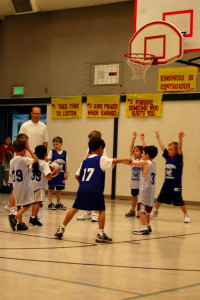Advice for Teaching the Technique of the Lay-up for Junior Players
Missing Lay-ups is one of those scenarios many coaches face on a daily basis with their young and developing teams. This is a common problem and one that is compounded by the fact that the reasons for this issue are often overlooked. As one of the fundamental offensive skills taught in basketball it comes as no surprise this also the most important for junior players to develop. Unfortunately, however the lay-up while a skill commonly taught at the junior levels continues to plague some senior players as a problem in their overall game as well.
There are a number of different areas to examine when looking at a junior players performance of a lay-up. For each player they might have a significant problem in one area or multiple areas depending on what exactly their performance is like.

For junior players often rehearsal of the skill is an issue. Players must have ample opportunity to practice the skill under direct supervision and receive ongoing feedback. Because the lay-up is used so frequently within a game of basketball it needs to be practiced extensively and within a number of different scenarios to help the development of the player.
Initially, players will just need to practice the form and technique of the lay-up. This should be practiced without a dribble. Adding a dribble straight away only serves to distract players from focusing on the real goal, which is their footwork. Start with only one-step and gradually extend so players learn to use two-steps prior to attempting the jump and shooting action of the lay-up. From this point players can have the distanced increased from the basket so they use one dribble and then two dribbles prior to picking up the basketball, and then performing the lay-up action.
As a rough guide players who are twelve or older should be trying to extend themselves so that when they are on the three-point line they take one dribbler and two steps before making the lay-up. This of course will be very dependent on the anatomy and physiology of your players.
Additionally many coaches are often very concerned with players when they are first starting with the sport who lay the ball up with two hands. If the player is under the age of ten years, there really is no concern. Scoring is a very important part of enjoyment for many players and removing this opportunity for the sake of technique (especially in younger players) only serves to make the sport of basketball less appealing. For young players they will even need variations in their footwork so they can perform the lay-up action under control. Allow junior players initially to finish in a jump-stop before shooting if this helps.
As a coach always focus on footwork for these younger athletes but remember that basketball needs to be inclusive of younger players, not exclusive.
Following the introduction of the fundamental technique and form players should then be exposed to defence and the linking of the lay-up with other tactical scenarios like 1 v 1, 2 v 1 and 2 v 2 to allow for the fastest possible development.
The lay-up should be afforded time in every training session for junior players to help with their performance of the skill. This will help the individual player and their enjoyment of basketball to grow the flourish so they have a long and lasting relationship with the sport. Not to mention it will also help your team’s shooting percentage.
Related articles






